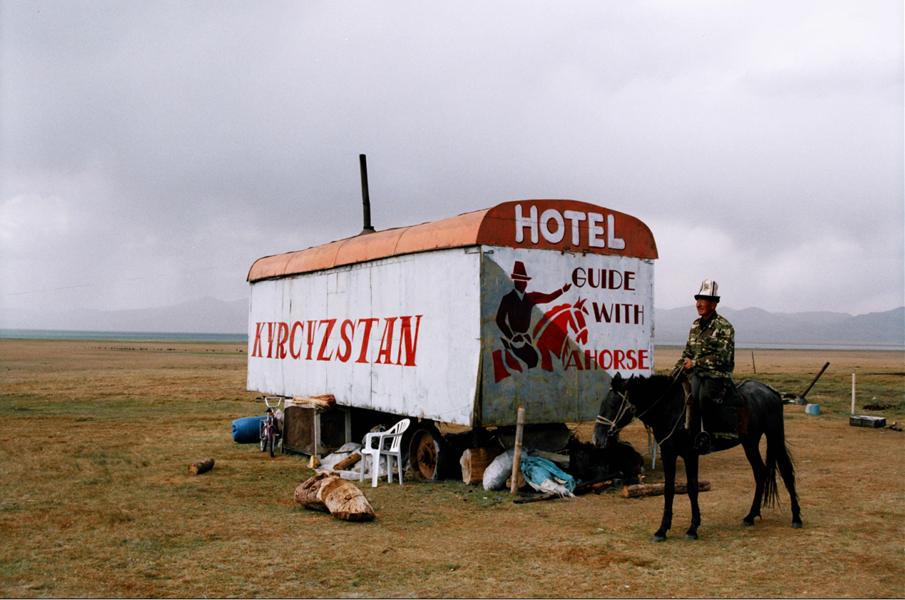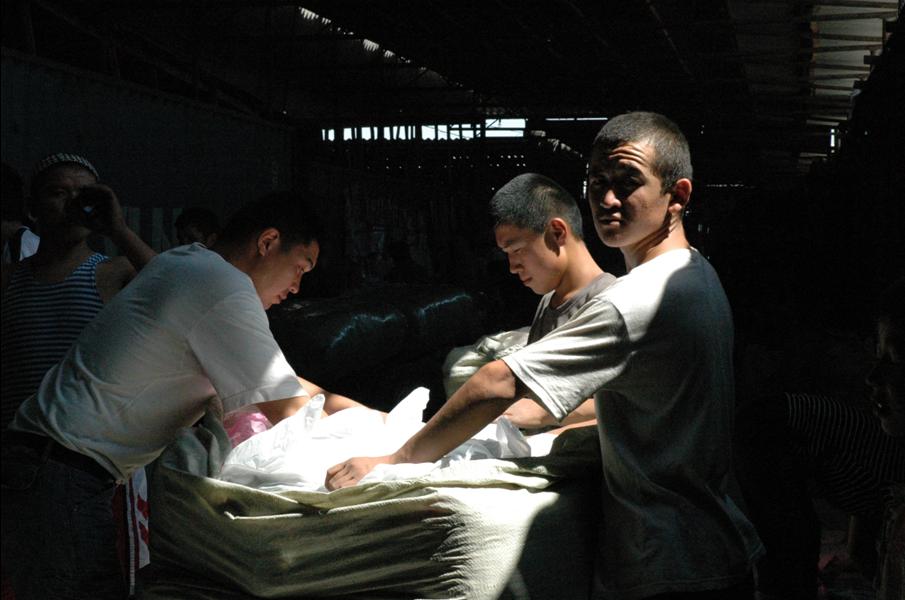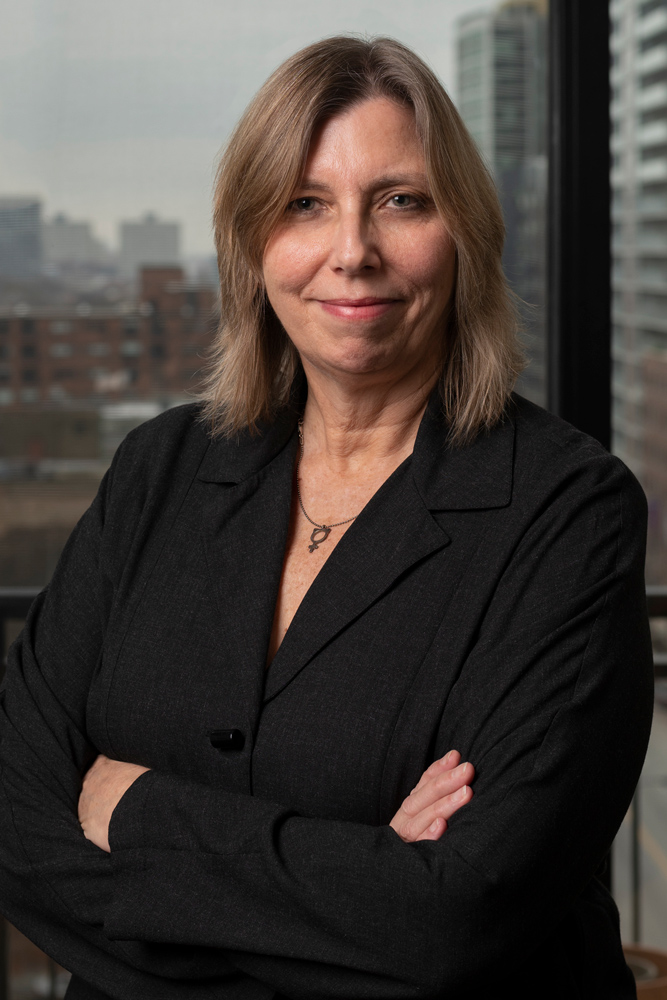Gulnara Kasmalieva and Muratbek Djumaliev’s A New Silk Road: Algorithm of Survival and Hope
Gulnara Kasmalieva and Muratbek Djumaliev’s A New Silk Road: Algorithm of Survival and Hope; The Art Institute of Chicago, February 1-May 6, 2007
The photographs and video installations of Gulnara Kasmalieva and Muratbek Djumaliev draw on various documentary styles and techniques to capture the changing social landscape of their native Kyrgyzstan since it became an independent republic in 1991. Like many artists of post-Soviet Europe and Central Asia, their practice is a discursive one that casts a critical yet empathetic eye on their indigenous subjects (human and otherwise) and the political spaces they occupy.
Their collaborative projects engage in what Thomas McEvilley (quoting George Marcus and Michael Fisher) terms “anthropology as cultural critique,” in his description of several works exhibited in the video festival “Videoidentity: Sacred Places of Central Asia”.Thomas McEvilley, “Report from Central Asia: Video Comes to the ‘Stans,’” Art in America, December 2005. “Videoidentity: Sacred Places of Central Asia” took place in Almaty, Kazakhstan in fall 2004. Applying the term to Kasmalieva and Djumaliev’s work (also included), the artists assume the role of detached, albeit informed strangers to create a multi-sited ethnography of place that considers intercultural systems alongside local and global relations.
In all of the artists’ work, the diversity of Kyrgyz identity is examined against the backdrop of a complex, layered history that includes nomadic traditions based in pastoralism followed by centuries of colonist rule. The country’s central position between Asia and Russia accounts for its multiethnic population; once an important trade station along the renowned Silk Road, it was truly a cultural crossroads. Much of its modern history was spent in subjugation to first the Russian Empire, then the Soviet Union who imposed decades of enforced settlement, collective farming, and unregulated industrialization, among other abuses of civic and economic freedom.
Kyrgyzstan’s difficult transition to independence is the subject of Kasmalieva’s and Dujumaliev’s internationally acclaimed multimedia works. Based in the capital city of Bishkek, they document the effects of political upheaval and transformation, in particular the decentralization and privatization of the country’s economic resources and their impact on traditional ways of life. In the series New Menhirs (2005), for example, color photographs of crumbling factories stand as haunting reminders of a utopia never achieved. Desolate industrial landscapes similarly inhabit the dual-channel video Into the Future (2005); when juxtaposed with images of passengers boarding a Siberian ferry, they create a portrait of the present confronting its past while facing an uncertain future.
The video installations and photographs in A New Silk Road: Algorithm of Survival and Hope, recently on view at the Art Institute of Chicago, record the trials and triumphs of the Kyrgyz Republic’s emergent market system as it defines itself within global capitalism. The country’s leading exports areprimarily agricultural goods as well as nonferrous metals and minerals. Although Kyrgyzstan was the first former Soviet republic to join the World Trade Organization (in 1998), its market-oriented policies have been countered by economic hardship and political instability, resulting in the overthrow of former President Askar Akayev in 2005. Yet despite new democratic reforms, skepticism is pervasive.
For the Art Institute, Kasmalieva and Djumaliev recast Trans-Siberian Amazons (2004), previously shown in the Central Asian Pavilion of the 51st Venice Biennale. This more minimalist, three-channel version of the original video installation portrays two women who, out of economic necessity, must trade domestic goods to train passengers traveling across Central Asia. The elder woman woefully sings a Soviet-era pop song about a lost love, while her companion smiles in comfort and admiration. Framing this central scene are two screens, each depicting mirror images of the same seemingly endless stretch of railway track as it traverses a barren landscape. These women are both the casualties and the heroines of the country’s still harsh economic reality, as the artists acknowledge the essential role women play in providing for their families.
Projected onto five screens that play simultaneously is the video installation A New Silk Road: Algorithm of Survival and Hope, created specifically for the Art Institute. Here, the artists follow a caravan of trucks transporting scrap metal from Kyrgyzstan to western China, recording a different aspect of the country’s transient economy. The opening scene captures the arduous task of collecting and sorting the metal, which is then loaded onto worn green trucks. Making their way through dusty mountain roads, the trucks next land at a bustling marketplace; workers bundling and taping large packages add to the cacophony of sight and sound. Viewers are returned to the traveling fleet that eventually stops for repairs along a rural stretch of road, where villagers whose livelihoods depend on such transients greet the drivers.
The work reaches a climax when all are united by a man singing a traditional folk song; in the final scene, a young boy on ahorse trails the trucks as they drive into the distant horizon. Throughout the video, there are echoes of Moldavian artist Pavel Braila’s Shoes for Europe (2000), a film that details the painstaking process of changing the wheels of a train commuting east to west from the Russian gauges still used in Moldavia to those used in Western Europe. Similar issues of labor, the duality between East and West, between past and future infuse A New Silk Road. However, Djumaliev and Kasmalieva shun the cool objectivity found in Braila’s work for a more subjective reality. For instance, at various moments the artists’ subjects are keenly aware of the camera’s presence (as is true in Trans-Siberian Amazons, in which the women are shot in an intimate cinema verite). This humanistic approach is enhanced by the employment of multiple screens that cast slightly different views of the same scene while creating a sense of dislocation, and by the artists’ ability to construct an experience that is pleasurably visual.
 Accompanying this work are twenty-three digital prints, many of which are stills from the video. Other images capture the diversity of roles played by the Kyrgyz people in the new market-oriented economy, mainly those who provide services to travelers on the New Silk Road. Included are men and women selling clothing and mannequins from the backs of trucks, a hamburger vendor at a roadside stand, and a man who gives guided tours on horseback and whose trailer was converted to a hotel.
Accompanying this work are twenty-three digital prints, many of which are stills from the video. Other images capture the diversity of roles played by the Kyrgyz people in the new market-oriented economy, mainly those who provide services to travelers on the New Silk Road. Included are men and women selling clothing and mannequins from the backs of trucks, a hamburger vendor at a roadside stand, and a man who gives guided tours on horseback and whose trailer was converted to a hotel.
A feeling of rhythm unites the video works, from the use of folk songs to the pulse of the train to the clamor of metal. Interwoven throughout the exhibition is the sense of tradition and human spirit that survives despite adversity (suggested by the algorithm of the show’s title), one that connects Kyrgyzstan’s past and future, allowing it to preserve its cultural identity while engaging the larger world. In essence, Kasmalieva and Djumaliev point to a new nomadicism that creates economic opportunities as well as the promise of hope.







